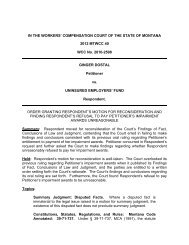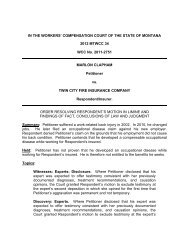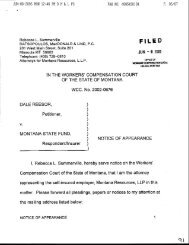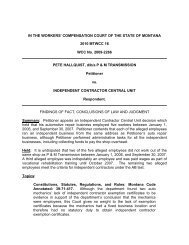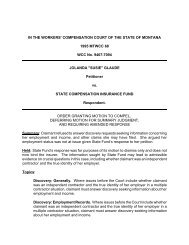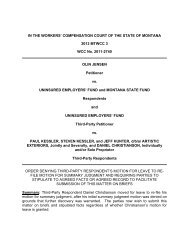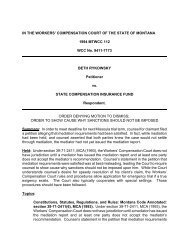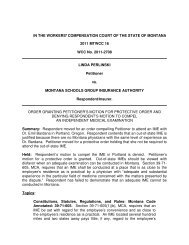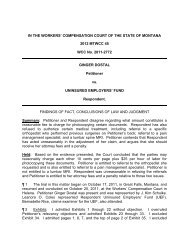Findings of Fact, Conclusions of Law and Judgment - Workers ...
Findings of Fact, Conclusions of Law and Judgment - Workers ...
Findings of Fact, Conclusions of Law and Judgment - Workers ...
Create successful ePaper yourself
Turn your PDF publications into a flip-book with our unique Google optimized e-Paper software.
IN THE WORKERS’ COMPENSATION COURT OF THE STATE OF MONTANA2012 MTWCC 43WCC No. 2012-2939JEFFREY L. DRIVDAHLPetitionervs.ZURICH AMERICAN INSURANCE COMPANYRespondent/Insurer<strong>and</strong>BRENTWOOD SERVICES ADMINISTRATORS, INC.Third Party Adjuster.FINDINGS OF FACT, CONCLUSIONS OF LAW AND JUDGMENTSummary: Petitioner contends that he is permanently totally disabled due to hisindustrial injury. Respondent contends that Petitioner is not entitled to permanent totaldisability benefits because his treating physician has approved several job analyses.Held: The weight <strong>of</strong> the evidence supports Petitioner’s entitlement to permanent totaldisability benefits.Topics:Constitutions, Statutes, Regulations, <strong>and</strong> Rules: Montana CodeAnnotated: 39-71-609. Although an injured worker ordinarily bears theburden <strong>of</strong> proving that he is entitled to the benefits he seeks, under § 39-71-609(2), MCA, the insurer bears the initial burden to produce evidencethat the injured worker is not permanently totally disabled. WhereRespondent met its initial burden <strong>of</strong> pro<strong>of</strong> by introducing approved jobanalyses into evidence, the burden then shifts back to Petitioner to provethat, notwithst<strong>and</strong>ing the approved job analyses, he is entitled to PTDbenefits.
Pro<strong>of</strong>: Burden <strong>of</strong> Pro<strong>of</strong>: Permanent Total Disability. Although aninjured worker ordinarily bears the burden <strong>of</strong> proving that he is entitled tothe benefits he seeks, under § 39-71-609(2), MCA, the insurer bears theinitial burden to produce evidence that the injured worker is notpermanently totally disabled. Where Respondent met its initial burden <strong>of</strong>pro<strong>of</strong> by introducing approved job analyses into evidence, the burden thenshifts back to Petitioner to prove that, notwithst<strong>and</strong>ing the approved jobanalyses, he is entitled to PTD benefits.Pro<strong>of</strong>: Conflicting Evidence: Vocational. The Court assessed thecredibility <strong>of</strong> Petitioner <strong>and</strong> Petitioner’s son, both <strong>of</strong> whom testified.However, the Court was unable to fully explore the bases for the opinions<strong>of</strong> two doctors <strong>and</strong> a physical therapist as only their reports <strong>and</strong>/or medicalrecords were entered into evidence. While the treating physicianapproved several job analyses, his opinion differed significantly from theother experts in the case <strong>and</strong> differed from the live testimony. Since theCourt had no insight into why this doctor’s opinion differed, the Court didnot give the opinion as much weight. 1 The trial in this matter occurred on August 31, 2012, at the <strong>Workers</strong>’Compensation Court. Petitioner Jeffrey L. Drivdahl was present <strong>and</strong> was representedby Bernard J. Everett. Todd A. Hammer represented Respondent Zurich AmericanInsurance Company (Zurich) <strong>and</strong> Third Party Adjuster Brentwood ServicesAdministrators, Inc. (Brentwood). Jim Putman, Senior Claims Examiner for Brentwood,also attended. 2 Exhibits: I admitted Exhibits 1 through 9 without objection. 3 Witnesses <strong>and</strong> Depositions: Drivdahl’s deposition was submitted to the Court<strong>and</strong> is considered part <strong>of</strong> the record. Drivdahl, Putman, Bonnie L. Lyytinen-Hale, M.S.,C.R.C., <strong>and</strong> Joel Drivdahl were sworn <strong>and</strong> testified. 4 Issues Presented: At trial, the Court restated the issues as follows:Issue One: Whether Drivdahl is entitled to permanent total disabilitybenefits; <strong>and</strong>Issue Two: Whether Drivdahl is entitled to his costs.<strong>Findings</strong> <strong>of</strong> <strong>Fact</strong>, <strong>Conclusions</strong> <strong>of</strong> <strong>Law</strong> <strong>and</strong> Order – Page 2
FINDINGS OF FACT 5 On December 21, 2009, Drivdahl sustained injuries while in the course <strong>and</strong>scope <strong>of</strong> his employment as a driver for Kenco Group. Zurich insured Kenco Group atthat time. Kenco Group also used Brentwood as a third-party administrator. Zurichaccepted liability for Drivdahl’s injuries <strong>and</strong> paid certain medical <strong>and</strong> indemnity benefits. 1 6 Drivdahl testified at trial. I found him to be a credible witness. Drivdahl testifiedthat since his industrial accident, he has undergone three or four surgeries on his leftshoulder. However, he has endured constant pain in his shoulder. He considers hisshoulder to be his most significant problem. 2 Drivdahl further testified that his rightelbow is “very tender” <strong>and</strong> he cannot tolerate having anything touch it. He has a poorgrip with his right h<strong>and</strong> <strong>and</strong> he frequently drops things. 3 His pain level worsens withactivity. 4 7 Drivdahl owns <strong>and</strong> maintains a residence in Whitehall, Montana. He described itas a two-acre piece <strong>of</strong> property with an approximately 1100 square foot home. 5 Theproperty also includes a shop building <strong>and</strong> two garages. 6 Drivdahl performs his ownhousekeeping <strong>and</strong> home maintenance, 7 but he relies upon his son to complete sometasks for him to avoid increasing his pain, including changing oil or performing otherautomobile maintenance <strong>and</strong> repairing the property’s fence. 8 Drivdahl stated that hecan usually tolerate 10 to 15 minutes <strong>of</strong> household activities such as vacuuming beforehe needs to rest his shoulder. 9 8 Drivdahl testified that he enjoys playing the guitar as a hobby, but he is no longerable to play for more than five to ten minutes at a time because <strong>of</strong> his shouldercondition. 10 Drivdahl also testified that prior to his industrial injury, he enjoyed recreatingwith an ATV, but he can no longer comfortably operate an ATV. 11 Drivdahl testified that1 Pre-Trial Order at 2.2 Trial Test.3 Trial Test.4 Drivdahl Dep. 63:17-19.5 Drivdahl Dep. 44:21 – 45:24.6 Drivdahl Dep. 46:8-14.7 Drivdahl Dep. 66:4-13.8 Drivdahl Dep. 65:2-18.9 Trial Test.10 Drivdahl Dep. 48:2-10.11 Drivdahl Dep. 48:22 – 49:8.<strong>Findings</strong> <strong>of</strong> <strong>Fact</strong>, <strong>Conclusions</strong> <strong>of</strong> <strong>Law</strong> <strong>and</strong> Order – Page 3
he is able to drive his personal automobiles <strong>and</strong> pick-up truck locally, but he is no longerable to tolerate driving longer distances because <strong>of</strong> his shoulder condition. 12 Drivdahltestified that he is able to tolerate st<strong>and</strong>ing for approximately 10 to 15 minutes at a timebefore his shoulder pain becomes intolerable. 13 9 Nicholas DiGiovine, M.D., treated Drivdahl for his injuries. The treatmentincluded multiple surgeries on Drivdahl’s left shoulder <strong>and</strong> elbow. 14 10 On April 19, 2011, Dr. DiGiovine indicated that Drivdahl was unable to return towork at that time, <strong>and</strong> that he was scheduled for a follow-up appointment in threeweeks. 15 However, the medical records submitted do not indicate that Drivdahl sawDr. DiGiovine until September 8, 2011. 11 Drivdahl testified that he discontinued taking prescriptive pain medications inmid-2011. 16 Drivdahl testified that Dr. DiGiovine initially prescribed him painmedications after his surgeries, but Dr. DiGiovine later ceased prescribing themedications <strong>and</strong> told Drivdahl he would have to learn to live with his shoulder pain. 17 12 Drivdahl testified that he currently alleviates his shoulder pain by lying down <strong>and</strong>resting his shoulder on a pillow. Drivdahl stated that this lessens his pain but does noteliminate it. Drivdahl testified that st<strong>and</strong>ing, walking, <strong>and</strong> sitting all exacerbate hisshoulder pain because <strong>of</strong> the weight <strong>of</strong> his arm hanging on it. He further testified thathe has tried using a sling, but it aggravates his pain as well. 18 13 On September 8, 2011, Dr. DiGiovine evaluated Drivdahl <strong>and</strong> noted thatDrivdahl’s complaints remained unchanged “since his last visit.” Dr. DiGiovinediagnosed Drivdahl with status post right arm cubital tunnel, carpal tunnel <strong>and</strong> ulnartunnel releases <strong>and</strong> revision lateral epicondyle; status post left shoulder SLAP repair;post-operative frozen shoulder; biceps tenodesis left shoulder; <strong>and</strong> status postmanipulation <strong>and</strong> debridement left shoulder. Dr. DiGiovine noted that he believedDrivdahl had “plateaued” <strong>and</strong>, “I am still concerned about the possibility <strong>of</strong> somesecondary gain with regards to his complaints.” Dr. DiGiovine recommended an12 Drivdahl Dep. 50:5-19.13 Drivdahl Dep. 70:1-4.14 Pre-Trial Order at 2.15 Ex. 1 at 16.16 Drivdahl Dep. 59:8-23.17 Trial Test.18 Trial Test.<strong>Findings</strong> <strong>of</strong> <strong>Fact</strong>, <strong>Conclusions</strong> <strong>of</strong> <strong>Law</strong> <strong>and</strong> Order – Page 4
independent medical examination (IME) <strong>and</strong> functional capacity evaluation (FCE) priorto making a maximum medical improvement (MMI) determination. 19 14 On October 4, 2011, Drivdahl underwent an IME conducted by Catherine C.Capps, M.D. Dr. Capps prepared an IME report on November 6, 2011, in which shesummarized Drivdahl’s medical history, her examination impressions, <strong>and</strong> her interview<strong>of</strong> Drivdahl. She opined that Drivdahl suffered from a ruptured left bicep, discomfortover his left acromioclavicular joint, <strong>and</strong> some dysconjugation <strong>of</strong> left shoulder motion.Dr. Capps also found Drivdahl to have an irritable ulnar nerve near his right elbow. 20Dr. Capps suggested that transposing Drivdahl’s ulnar nerve at the elbow might providehim some relief. 21 Dr. Capps further suggested that injections into Drivdahl’s leftacromioclavicular joint might alleviate his left shoulder symptoms. 22 15 On October 13 <strong>and</strong> 14, 2011, Drivdahl submitted to an FCE conducted byphysical therapist Kevin Stenson. Stenson noted that Drivdahl “fully participated” in theFCE <strong>and</strong> his responses were consistent with maximal effort. 23 Stenson opined thatDrivdahl’s left shoulder, right elbow, <strong>and</strong> right wrist problems, along with otherdiagnoses including left knee pain “prevents a match between client’s physical abilities<strong>and</strong> return to work.” 24 16 On November 18, 2011, Dr. DiGiovine wrote to Jim Putman, Senior ClaimsExaminer for Brentwood, in response to questions Putman posed on November 14.Dr. DiGiovine opined that Drivdahl was not at MMI <strong>and</strong> explained that he intended totreat Drivdahl with a cortisone injection <strong>and</strong> local anesthetic into the leftacromioclavicular joint to determine if this treatment would give Drivdahl pain relief. 25 17 On January 12, 2012, Dr. DiGiovine saw Drivdahl for a follow-up appointment.Dr. DiGiovine noted that the shoulder injections did not relieve Drivdahl’s symptoms <strong>and</strong>that Drivdahl did not wish to pursue ulnar nerve surgery. Dr. DiGiovine did notrecommend further treatment. Dr. DiGiovine found Drivdahl to be at MMI <strong>and</strong>calculated Drivdahl’s impairment rating as an 11% whole person impairment. 2619 Ex. 7 at 1.20 Ex. 3 at 11.21 Id.22 Ex. 3 at 12.23 Ex. 4 at 2.24 Ex. 4 at 3.25 Ex. 1 at 36.26 Ex. 7 at 3-4.<strong>Findings</strong> <strong>of</strong> <strong>Fact</strong>, <strong>Conclusions</strong> <strong>of</strong> <strong>Law</strong> <strong>and</strong> Order – Page 5
18 On February 15, 2012, Dr. DiGiovine approved job analyses Bonnie L. Lyytinen-Hale, M.S., C.R.C., prepared for hotel / motel desk clerk, pit stop service advisor, autoparts clerk / delivery driver, cashier, <strong>and</strong> convenience store clerk. Dr. DiGiovinedisapproved job analyses for Drivdahl’s time-<strong>of</strong>-injury position <strong>and</strong> for sales clerk / salesfloor associate. 27 19 Drivdahl testified that Dr. DiGiovine never discussed the job analyses with him. 28Drivdahl testified that he does not believe he could perform the convenience store clerkposition because he cannot carry things <strong>and</strong> he cannot tolerate being on his feet forlong periods <strong>of</strong> time “where that shoulder hangs all the time.” 29 Drivdahl further testifiedthat he would not be able to tolerate the repetitive lifting <strong>and</strong> the amount <strong>of</strong> driving whichan auto parts clerk / delivery driver position would require. 30 Drivdahl testified that healso did not believe he could perform the hotel / motel desk clerk position because hecould not tolerate being on his feet for a significant length <strong>of</strong> time <strong>and</strong> he could not usehis arms to complete the job duties. 31 20 On February 21, 2012, Lyytinen-Hale prepared an Employability <strong>and</strong> Wage LossAnalysis regarding Drivdahl at Putman’s request. 32 Lyytinen-Hale testified at trial. Ifound her to be a credible witness. Based upon the Employability <strong>and</strong> Wage LossAnalysis which she prepared <strong>and</strong> Dr. DiGiovine’s approval <strong>of</strong> several job analyses, sheopined that Drivdahl has a reasonable prospect <strong>of</strong> performing regular <strong>and</strong> competitiveemployment in the labor market. 33 In her Employability <strong>and</strong> Wage Loss Analysis,Lyytinen-Hale found that Drivdahl was not able to return to his time-<strong>of</strong>-injury position<strong>and</strong> that his time-<strong>of</strong>-injury employer did not have a permanent modified or alternateposition available to him. 34 Lyytinen-Hale opined that Drivdahl would experience anactual wage loss as a result <strong>of</strong> his industrial injury. She noted that Drivdahl would beentitled to rehabilitation benefits <strong>and</strong> requested that he contact her if interested invocational rehabilitation services. 3527 Ex. 5.28 Drivdahl Dep. 67:15-23.29 Drivdahl Dep. 68:2-10.30 Drivdahl Dep. 68:21 – 69:2.31 Drivdahl Dep. 69:3-12.32 Ex. 8.33 Trial Test.34 Ex. 8 at 5.35 Ex. 8 at 16.<strong>Findings</strong> <strong>of</strong> <strong>Fact</strong>, <strong>Conclusions</strong> <strong>of</strong> <strong>Law</strong> <strong>and</strong> Order – Page 6
21 Drivdahl testified that he has not looked for work since his industrial injury. 36Drivdahl testified that when Lyytinen-Hale discussed the possibility <strong>of</strong> retraining, he wasinterested in the idea, but he did not know how to go about pursuing vocationalrehabilitation. He stated that he could not recall seeing a letter Lyytinen-Hale sent to hisattorney in February 2012 which asked Drivdahl to contact her if he was interested invocational rehabilitation. 37 22 Joel Drivdahl testified at trial. I found him to be a credible witness. Joel isDrivdahl’s son. Joel resides in Belgrade, Montana, <strong>and</strong> travels to Whitehall to visitDrivdahl approximately three times per month. Joel testified that prior to Drivdahl’sindustrial injury, they enjoyed recreational activities together. Joel testified that Drivdahlwas an active person with no physical limitations. 38 23 Joel testified that Drivdahl’s activity level dropped dramatically after his industrialaccident. Joel now cuts Drivdahl’s firewood <strong>and</strong> performs vehicle maintenance forhim. 39 Joel has helped Drivdahl with housecleaning which involves reaching overhead<strong>and</strong> moving furniture. Joel testified that he has observed Drivdahl tire quickly withactivities <strong>and</strong> he lies down on the couch frequently to rest his shoulder. 40 Joel testifiedthat he has not observed Drivdahl being active for more than half an hour or 45 minuteswithout resting his shoulder. 41CONCLUSIONS OF LAW 24 This case is governed by the 2009 version <strong>of</strong> the Montana <strong>Workers</strong>’Compensation Act since that was the law in effect at the time <strong>of</strong> Drivdahl’s industrialaccident. 42 Ordinarily, an injured worker bears the burden <strong>of</strong> proving by apreponderance <strong>of</strong> the evidence that he is entitled to the benefits he seeks. 43 However,under § 39-71-609(2), MCA, the insurer bears the initial burden to produce evidenceshowing that the injured worker is not permanently totally disabled. 4436 Drivdahl Dep. 55:18-20.37 Drivdahl Dep. 43:17 – 44:9.38 Trial Test.39 Trial Test.40 Trial Test.41 Trial Test.42Buckman v. Montana Deaconess Hosp., 224 Mont. 318, 321, 730 P.2d 380, 382 (1986).43 Ricks v. Teslow Consol.,162 Mont. 469, 512 P.2d 1304 (1973); Dumont v. Wickens Bros. Constr. Co., 183Mont. 190, 598 P.2d 1099 (1979).44 See Weisgerber v. American Home Assurance Co., 2005 MTWCC 8, 32.<strong>Findings</strong> <strong>of</strong> <strong>Fact</strong>, <strong>Conclusions</strong> <strong>of</strong> <strong>Law</strong> <strong>and</strong> Order – Page 7
25 Section 39-71-609(2), MCA, states:Temporary total disability benefits may be terminated on the date that theworker has been released to return to work in some capacity. Unless theclaimant is found, at maximum healing, to be without a permanentphysical impairment from the injury, the insurer, prior to convertingtemporary total disability benefits or temporary partial disability benefits topermanent partial disability benefits:(a) must have a physician’s determination that the claimant hasreached medical stability;(b) must have a physician’s determination <strong>of</strong> the claimant’sphysical restrictions resulting from the industrial injury;(c) must have a physician’s determination, based on thephysician’s knowledge <strong>of</strong> the claimant’s job analysis prepared by arehabilitation provider, that the claimant can return to work, with or withoutrestrictions, on the job on which the claimant was injured or on another jobfor which the claimant is suited by age, education, work experience, <strong>and</strong>physical condition;(d) shall give notice to the claimant <strong>of</strong> the insurer’s receipt <strong>of</strong> thereport <strong>of</strong> the physician’s determinations required pursuant to subsections(2)(a) through (2)(c). The notice must be attached to a copy <strong>of</strong> the report. 26 In the present case, there does not appear to be any dispute that Zurich has metits initial burden; while the parties disagree as to whether Dr. DiGiovine’s approval <strong>of</strong>several job analyses is correct, neither disputes that Dr. DiGiovine made adetermination that Drivdahl can return to work. Therefore, the burden shifts back toDrivdahl to prove that, notwithst<strong>and</strong>ing the approved job analyses, he is entitled topermanent total disability (PTD) benefits.Issue One: Whether Drivdahl is entitled to permanent total disability benefits 27 A worker is permanently totally disabled if, after reaching MMI, he has a physicalcondition resulting from an injury in which he does not have a reasonable prospect <strong>of</strong>physically performing regular employment. 45 The determination <strong>of</strong> entitlement to PTDbenefits must be supported by a preponderance <strong>of</strong> objective medical findings. 46 28 The facts <strong>of</strong> Drivdahl’s case are largely undisputed <strong>and</strong> are readily apparent. It isthe Court’s job to weigh them. On the one h<strong>and</strong>, Drivdahl’s treating physician approvedseveral job analyses. It is clear from Dr. DiGiovine’s medical notes that he had45 § 39-71-116(25), MCA.46 § 39-71-702(2), MCA.<strong>Findings</strong> <strong>of</strong> <strong>Fact</strong>, <strong>Conclusions</strong> <strong>of</strong> <strong>Law</strong> <strong>and</strong> Order – Page 8
concerns about the extent <strong>of</strong> Drivdahl’s reported pain complaints. Dr. DiGiovine notedthat he believed secondary gain may be a factor in Drivdahl’s stalled recovery. At somepoint, Dr. DiGiovine also ceased prescribing pain medication to Drivdahl. 29 On the other h<strong>and</strong>, from the objective medical evidence there is no doubt thatDrivdahl suffered significant injuries in his industrial accident <strong>and</strong> that he has ongoinglimitations due to those injuries. Dr. Capps noted several findings in her IME report <strong>and</strong>made additional treatment recommendations which were unfortunately not successful inimproving Drivdahl’s condition. Stenson, the FCE evaluator, found Drivdahl to exertmaximal effort during the FCE <strong>and</strong> ultimately concluded that Drivdahl’s physicallimitations were incompatible with gainful employment. 30 I heard Drivdahl’s testimony, had the opportunity to observe him at trial, <strong>and</strong> Ifound him credible. I further heard the testimony <strong>of</strong> Joel Drivdahl, which was likewisecredible, <strong>and</strong> which corroborated Drivdahl’s account <strong>of</strong> his physical limitations. 31 I do not know why Dr. DiGiovine viewed Drivdahl’s complaints with someskepticism. As Drivdahl’s treating physician, Dr. DiGiovine was intimately familiar withthe details <strong>of</strong> Drivdahl’s condition, including multiple surgeries <strong>and</strong> various othertreatments. As noted in the findings above, Dr. DiGiovine requested that Drivdahlundergo an FCE prior to making MMI <strong>and</strong> impairment rating determinations. However,for reasons not readily apparent to this Court, Dr. DiGiovine disregarded the FCEevaluator’s opinion that Drivdahl’s physical limitations precluded employability. SinceDr. DiGiovine did not testify either at trial or by deposition, I have no insight into hisrationale in approving these particular job analyses <strong>and</strong> I do not know what role, if any,his apparent skepticism about the extent <strong>of</strong> Drivdahl’s complaints played in his decision. 32 As a general rule, the opinion <strong>of</strong> a treating physician is accorded greater weightthan the opinions <strong>of</strong> other expert witnesses. However, a treating physician’s opinion isnot conclusive. To presume otherwise would quash the role <strong>of</strong> the fact finder inquestions <strong>of</strong> an alleged injury. As the finder <strong>of</strong> fact, this Court remains in the bestposition to assess witnesses’ credibility <strong>and</strong> testimony. 47 33 In the present case, I am able to assess the credibility <strong>of</strong> Drivdahl <strong>and</strong> his sonJoel. Since Dr. Capps, Dr. DiGiovine, <strong>and</strong> Stenson did not testify, I have only theirrespective reports <strong>and</strong> medical records from which to glean information. BothDr. Capps <strong>and</strong> Stenson found Drivdahl’s reported pain complaints <strong>and</strong> limitationscredible. Stenson clearly believed Drivdahl’s limitations were too severe for him toreturn to gainful employment. Drivdahl’s testimony, corroborated by Joel, likewiseindicates that he is physically able to engage in physical activity for, at the very most, 4547 EBI/Orion Group v. Blythe, 1998 MT 90, 12-13, 288 Mont. 356, 957 P.2d 1134.<strong>Findings</strong> <strong>of</strong> <strong>Fact</strong>, <strong>Conclusions</strong> <strong>of</strong> <strong>Law</strong> <strong>and</strong> Order – Page 9
minutes at a time. Given this limitation, I cannot find that Drivdahl would be able toperform any <strong>of</strong> the positions which Dr. DiGiovine approved. I note that Lyytinen-Hale’sopinion regarding Drivdahl’s employability is based upon Dr. DiGiovine’s approval <strong>of</strong> thejob analyses. With no insight into why Dr. DiGiovine was <strong>of</strong> a different opinion than theother experts in this case, I cannot give his opinion as much weight. 34 Reviewing the evidence in its entirety, I conclude that the preponderance <strong>of</strong> theevidence weighs in Drivdahl’s favor <strong>and</strong> he has met his burden <strong>of</strong> pro<strong>of</strong>. He is thereforeentitled to the PTD benefits he seeks.Issue Two: Whether Drivdahl is entitled to his costs 35 Since Drivdahl is the prevailing party, he is entitled to his costs. 48JUDGMENT 36 Petitioner is entitled to permanent total disability benefits. 37 Petitioner is entitled to his costs. 38 Pursuant to ARM 24.5.348(2), this <strong>Judgment</strong> is certified as final <strong>and</strong>, forpurposes <strong>of</strong> appeal, shall be considered as a notice <strong>of</strong> entry <strong>of</strong> judgment.DATED in Helena, Montana, this 16 th day <strong>of</strong> November, 2012.(SEAL)/s/ JAMES JEREMIAH SHEAJUDGEc: Bernard J. EverettTodd A. HammerSubmitted: August 31, 201248 § 39-71-611, MCA.<strong>Findings</strong> <strong>of</strong> <strong>Fact</strong>, <strong>Conclusions</strong> <strong>of</strong> <strong>Law</strong> <strong>and</strong> Order – Page 10


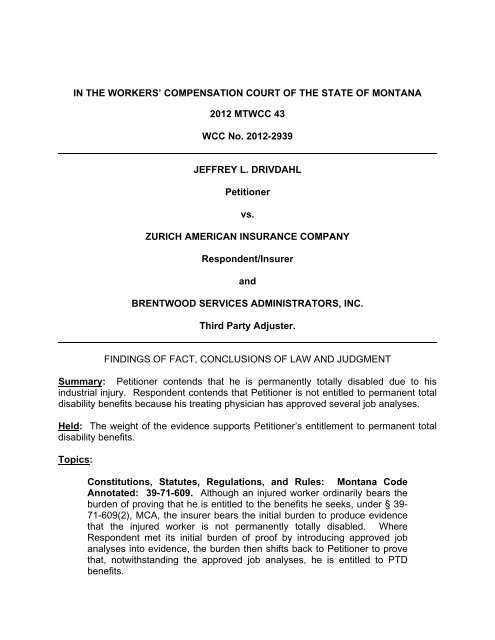
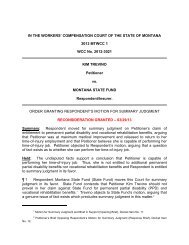
![Bustell v. AIG Claims Service, Inc. [05/03/05] 2005 MTWCC 23](https://img.yumpu.com/49777654/1/190x245/bustell-v-aig-claims-service-inc-05-03-05-2005-mtwcc-23.jpg?quality=85)
![Vallance v. MCCF [07/05/06] 2006 MTWCC 26 - Workers ...](https://img.yumpu.com/48724322/1/190x245/vallance-v-mccf-07-05-06-2006-mtwcc-26-workers-.jpg?quality=85)
